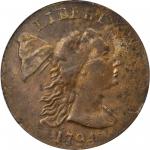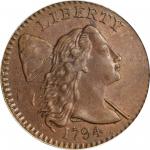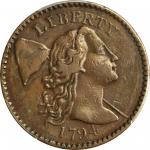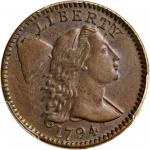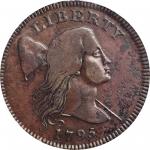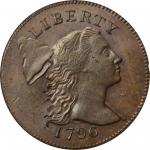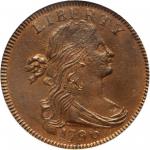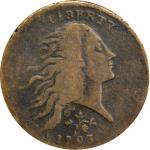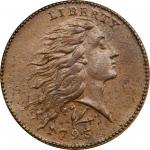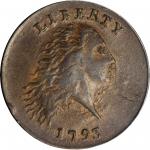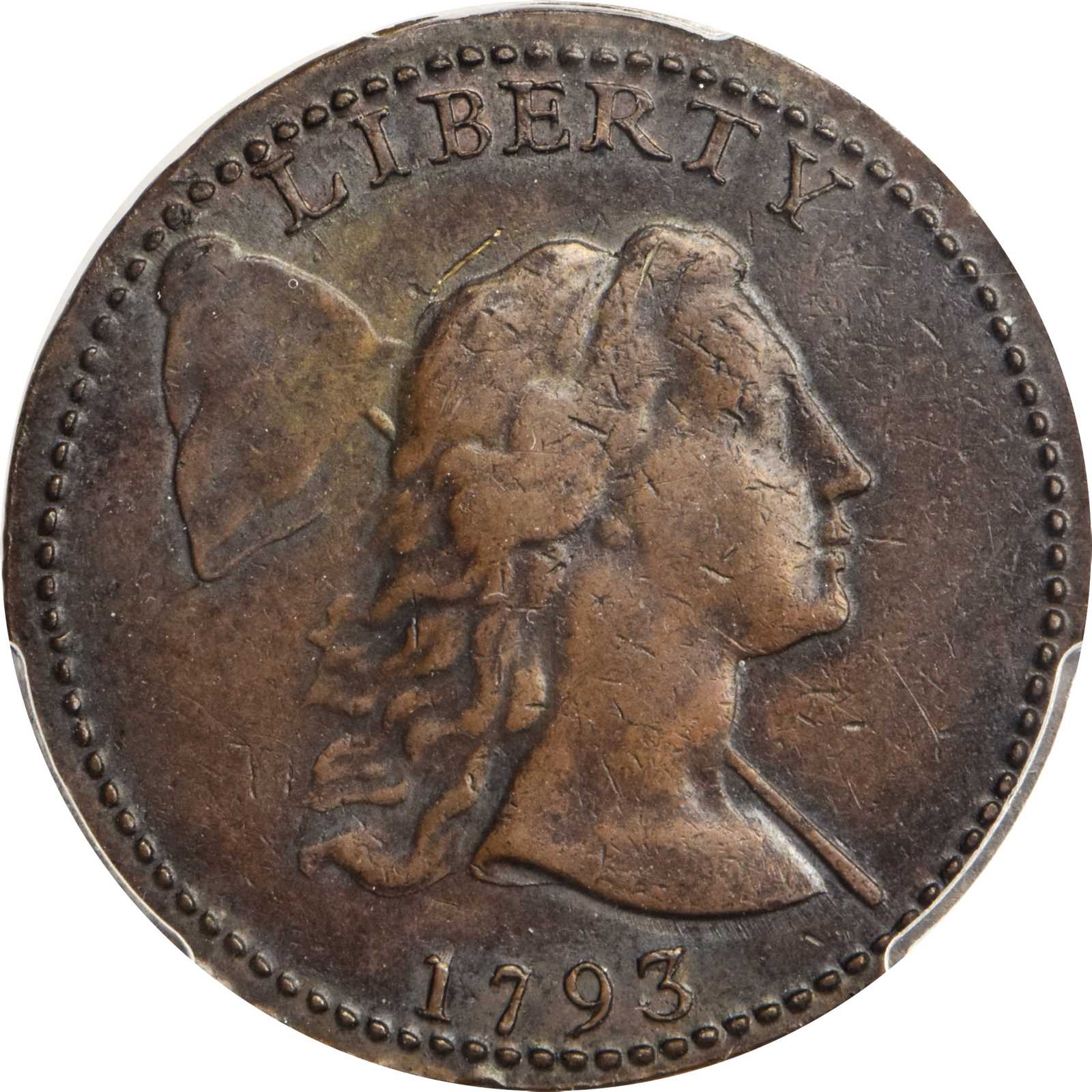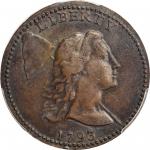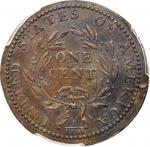1793 Liberty Cap Cent. S-13. Rarity-4-. AU-53 (PCGS).<strong>Type:</strong> Liberty Cap.<p><strong>Design:</strong> Obv: A head of Liberty faces right, the word LIBERTY above, the date 1793 below, and a liberty cap and pole behind the portrait. Libertys hair is partly confined by a narrow ribbon. The Liberty Cap motif closely resembles that on the obverse of Augustin Dupres famous Libertas Americana medal. Rev: A slender wreath surrounds the denomination ONE CENT, the base of the wreath bound by a ribbon tied into a bow. The legend UNITED STATES OF AMERICA is around the border and another expression of the denomination 1/100 is below.<p><strong>Weight Standard:</strong> 13.48 grams.<p><strong>Diameter:</strong> Approximately 29 mm.<p><strong>Die Variety:</strong> Sheldon-13, Breen-20. Obv: The letter L in the word LIBERTY nearly touches the border beads, with two beads directly centered over the adjacent letter I. This obverse is also used in the Sheldon-12 marriage. Rev: There are six berries on the left branch in the wreath, five on the right, and the single leaf below the letters ME in AMERICA closely parallels the branch stem. The digit 1 in the denominator is high, the fraction bar long and joined to the right ribbon end. This is a workhorse reverse die that also appears in the S-14, S-16 and NC-6 pairings.<p>There are no separate <em>Guide Book</em> varieties of the 1793 Liberty Cap cent, although many collectors view the 1793 as distinct from all other Liberty Cap cent issues due to its beaded (as opposed to denticulated) borders on both sides.<p><strong>Die State:</strong> Noyes A/A, Breen I. Obv: Perfect. Rev: Perfect, without the bulge that develops through the letters NT in CENT and eventually weakens CEN, the letter O in ONE, and the top of the bow.<p><strong>Edge:</strong> Lettered ONE HUNDRED FOR A DOLLAR followed by a single leaf.<p><strong>Mintage:</strong> The total mintage for the 1793 Liberty Cap cent is 11,056 coins, all of which were delivered on September 18 of that year. The coins were struck earlier, on July 18 and July 22.<p><strong>Estimated Surviving Population for the Die Variety:</strong> Rarity-4-: 159 to 200 coins in all grades.<p><strong>Strike:</strong> Minimally worn from what was obviously a brief stint in active circulation, this impressive coin retains sharp to full striking detail over virtually all design elements. Reverse detail is essentially full, the obverse sharp apart from softness to the hair curls behind the ear and at the top of Libertys head. Border beading is full around both sides, the impression only trivially off center to 5 oclock on the obverse, 11 oclock on the reverse.<p><strong>Surfaces:</strong> Marbled golden-brown and charcoal-copper patina is seen on both sides of this handsome and fully original piece. The surfaces are hard and tight with good gloss and faint traces of original luster. A few wispy handling marks are noted for the obverse, none worthy of individual attention. The reverse is smoother in this regard, although a few thin, shallow planchet flaws (as made) arc down from the viewers left to right at the letters UNITE in UNITED, from the letter A in STATES to the letter C in AMERICA, and from the letter O in OF to the border outside the letters ER in AMERICA. Eye appeal is strong in all regards.<p><strong>Commentary: </strong>An exceptional example of the scarce and challenging 1793 Liberty Cap cent, this coin ideally showcases the Liberty Cap design of Joseph Wright. As a 26-year-old portrait painter studying in London, Wright was dispatched to Paris to paint Benjamin Franklin. He spent much of the first half of 1782 in Passy, the Paris suburb that served as Franklins home in France. In March 1782, Franklin conceived a medal that would have tremendous influence on the future of American coinage and the numismatic legacy of Joseph Wright. On March 4 of that year Franklin wrote to Robert R. Livingston, who had served with Franklin on the committee to compose the Declaration of Independence: "This puts me in a mind of a medal I have had a mind to strike, since the late great event you gave me an account of, representing the United States." A year later, Franklins brainchild would be realized, and the Libertas Americana medal engraved by Augustin Dupre would become a sensation in Europe and America. Joseph Wright left Paris while the medal was still in its design stage, but its influence on his later works is clear. His Liberty Cap cent of 1793, the first examples of which were struck just a day before the 1793 half cents that displayed a similar design, copied the obverse of the Libertas Americana medal almost exactly. Franklins official explication or description of the medal, published in Paris in May 1783, describes the obverse portrait: "the head representing American Liberty has its tresses floating in the air, to show that she is in activity. The cap carried on a spear is her ensign." The cap, of course, is the Liberty cap, a stylized version of the pileus of classical times, a powerful symbol of freedom that was commonplace in England and America even before the American Revolution.<p>Many, perhaps most, of the leaders of the American Revolution were given examples of the Libertas Americana medal. Jeffersons was displayed in a frame at Monticello and described in his inventory of art as "a medal by Doctor Franklin." Washingtons, struck in silver, was housed in a sumptuous box that contained a set of medals struck in France to commemorate the Revolution. If Wright did not own one personally, the odds are good that others in his circle did, likely including Mint Director David Rittenhouse.<p>Joseph Wrights relationship to the United States Mint began even before coining did. He is known to have produced two works before the 1793 Liberty Cap cent (his final project). Their sequence is not known. Wrights 1792 "Eagle on Globe" pattern was almost certainly produced as an essay for the quarter dollar denomination and is an extreme rarity today, with examples are known in both copper and white metal. His medal for Henry Lee was the last entry into the Comitia Americana series, that comprised medals authorized by Congress to be presented to military leaders of the Revolution. While all others were engraved and struck in Paris in the 1780s, the Lee medal was somehow neglected. The obverse for Wrights portrait medal of Lee cracked in hardening, and strikes from his original dies are so rare today as to be entirely uncollectible. Both of these efforts preceded his 1793 Liberty Cap cent, of which four obverse and two reverse dies were produced.<p>Research by Bill Eckberg, published in <em>Penny-Wise</em> in September 2010, has shown that the 1793 Liberty Cap cents were struck on July 18 and July 22, indicating that the dies must have been executed some time earlier. (A nod goes to Bill for all of the incredible research he has done over the years; we are all the beneficiaries.) The fruits of the Mints labor for those two days amounted to 11,056 cents, representing the total of 1793 Liberty Cap cent production; all were delivered to the Mints treasurer on September 18. By the day they were inspected, counted, and turned over for distribution, Joseph Wright was dead, a victim of the plague that turned Philadelphia vacant during the late summer doldrums for years into the early 19th century: yellow fever.<p>Among Wrights last acts was to lodge a request with the United States government that his estate be paid for his two projects before his official employment as a Mint engraver. Mordecai Wetherill (mistranscribed in Taxay as "Moid Wetherill") was the son of Samuel Wetherill, a druggist who served as chairman of the Yellow Fever Committee of the Common Council of the city of Philadelphia in 1793. On September 11, 1793, when Wright was just a day or two from death, Wetherill was dispatched with a memo from Wright:<p><em>"Joseph Wright being very ill and not expecting to recover, requested the subscriber to make a memorandum as follows: that the said Joseph Wright had presented an account against the United States for cutting a medal, amount fifty guineas. Two essays of a quarter dollar, cut by direction of David Rittenhouse, Esqr. and presented to him (broke in hardening) value about 40 guineas."</em><p><em></em>On December 31, 1793, Thomas Jefferson officially closed the book on Joseph Wrights career with the Mint, issuing an order that asked for "Wrights representatives to be paid for engraving the medal of Govr Lee and (that being broke in hardening) another to be engraved." Yet, his artistic concept of Liberty lived on. The Liberty Cap design persisted on cents through 1796 (and most other denominations, sans cap), when the French association with the Libertas Americana apparently became too politically poisonous for the design to continue.<p>Sheldon-13 is one of six die marriages of this issue, popular with collectors as the first in the Liberty Cap series. It is the most readily obtainable variety of the 1793 Liberty Cap cent, although we caution bidders that the issue as a whole is scarce to rare in all grades. There is perhaps no better indication of this elusiveness than the rarity factors associated with the other five die marriages of this issue:<p>-Sheldon-12: Rarity-6-<p>-Sheldon-14: Rarity-5-<p>-Sheldon-15: Rarity-7-<p>-Sheldon-16: Rarity-6<p>-NC-6: Rarity-8<p>With perhaps not more than 200 coins extant in all grades, Sheldon-13 is certainly scarce in its own right, and it is rare in the finer circulated and all Mint State grades. The present example ranks among the finest known with an EAC grade of VF25(VF35) Average and CC#12/13 standing in the 2006 edition of the Noyes reference on large cents.PCGS# 1359. NGC ID: 223L.PCGS Population (all die marriages of the issue): 5; 7 finer, 2 of which are Mint State (MS-64+ BN finest).From the ESM Collection. Earlier ex "Colonel" E.H.R. Green; Green estate; partnership of Eric P. Newman and Burdette G. Johnson, doing business as St. Louis Stamp & Coin Co.; Eric P. Newman, acquired for $500, donated to the following on April 16, 1985; Eric P. Newman Numismatic Education Society; Heritages sale of the Eric P. Newman Collection, Part V, November 2014, lot 3087.

